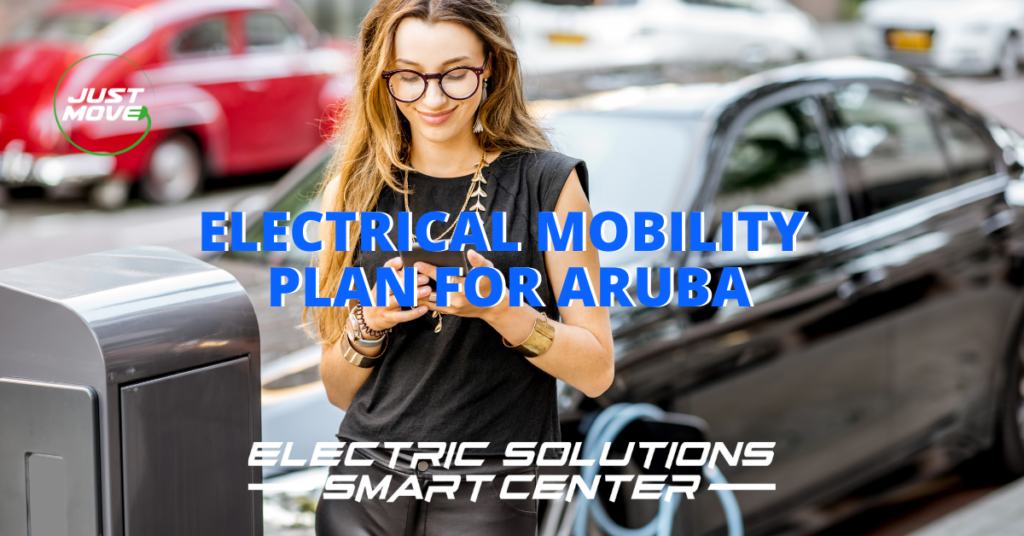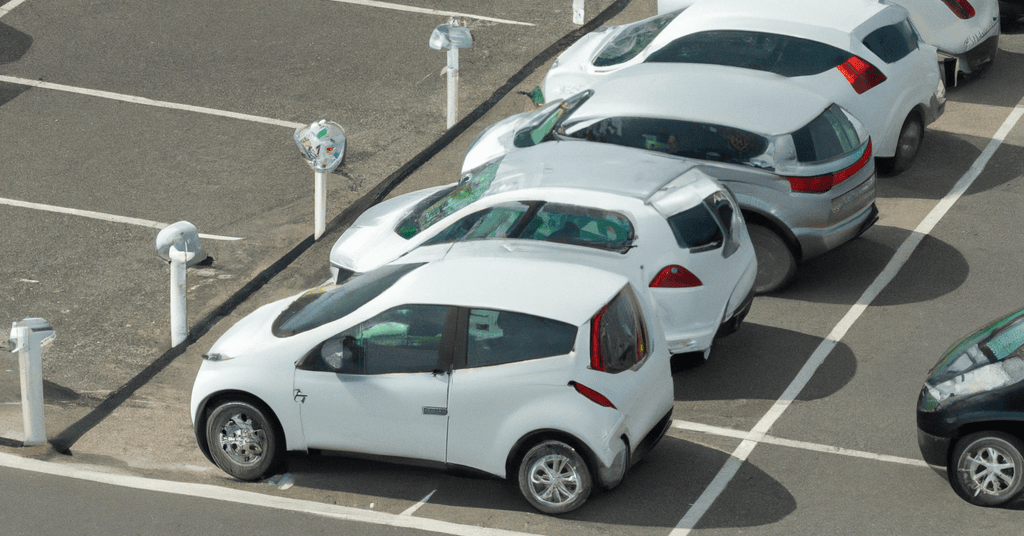ELECTRICAL MOBILITY PLAN FOR ARUBA
Table of Contents
Description and methodology for the preparation of Electric Mobility Plan for Aruba.
1.Context
The current mobility scene, largely dependent on use of private vehicles and fossil fuels, influences the quality of life of people and workers, also assuming both environmental, social and economic costs.
Today, mobility to work is the main reason for the everyday commuting and combustion car mode most used transport.
Greening these displacements is presented as a challenge to address, demanding to reduce energy consumption and increase intermodality with more efficient means of transport such as active mobility -foot, bicycle- and public transport, in addition of the optimization of trips with a private vehicle with the use of more efficient and low-emission technologies such as mobility electricity and the promotion of vehicle sharing.
This guide focuses on promoting Electric Mobility Plan for Aruba in the business environment.
One of the main objectives of the Comprehensive Electric Mobility Plan in Aruba is to encourage the transformation of the current fleet of vehicles, mostly diesel and gasoline, into electric vehicles.
Company fleets are a sector with high potential for electrification since they account for 33% of total registrations
annually and are more prone to electrification for environmental, economic and image reasons.
An Electric Mobility Plan in Aruba is a dynamic long-term strategy, the objective of which is to reduce the impact of work trips thanks to the incorporation of electric vehicles as an alternative to combustion vehicles.
Introduction
Definition
Strategy or group of actions that a company plans and implements to optimize the mobility of its workers, rationalizing travel, favoring the use of alternative modes of transport to private vehicles and trying to promote electric mobility plan in Aruba as an alternative to combustion vehicles.
The trips affected by a Mobility Plan for Companies can be grouped into:
- “In itinere”: movements of the employees to go to and from home to work.
- “In mission” or “In labore”: employee travel to carry out a mission or task related to their work during their working hours.
- Visitors / Suppliers: movements of visitors, customers and / or suppliers to the company mainly due to labor issues.
Electric Mobility refers to all vehicles (cars, vans, trucks, buses, motorcycles, mopeds, bicycles with electric assistance and other personal mobility systems such as scooters) that are powered by one or more electric motors, using electrical energy stored in rechargeable batteries and can be plugged into a compatible charging infrastructure.
These vehicles are:
- Pure battery electric vehicles (Battery Electric Vehicle, BEV).
- Range Extended Electric Vehicle (REEV).
- Plug-in hybrid electric vehicles (PHEV).
Objectives
The main objective of an Electric Mobility Plan in Aruba is to promote electric mobility among its employees, both in
company vehicles as individuals, and thus address the negative effects on the environment derived from emissionsfrom combustion vehicles.
The specific objectives are:
- Environment
- Company Workers
- Reduce greenhouse gas emissions, associated with other solutions for mobility like traditional combustion, and improve air quality.
- Increase the use of electric or low-emission vehicles, implying a reduction in energy consumed and less dependence on petroleum-derived fuels.
- Improve the quality of life of employees and reduce costs derived from travel to the workplace.
- Increase the efficiency of the company due to the lower consumption of the vehicles of
business. - Improve the accessibility of employees, clients, suppliers, etc. with
sharing, recharging or priority parking solutions.
Advantage
The advantages of an Electric Mobility Plan in Aruba are:
– Reduction of fixed costs associated with transportation and travel within the company.
– Increased productivity and satisfaction of employees due to the improvement of their quality of life.
– Greater cohesion of the workforce due to the fact of sharing trips.
– Improvement of the public image of the company due to its social and environmental commitment; being able to boost also through
the acquisition of certificates or green labels, incorporation into the quality, environmental and
human resources, organization of promotional campaigns and possible sponsorship of the low-emission vehicles purchased.
– Increase in available space thanks to the reduction of parking spaces.
– Acquisition of public incentives or tax reductions related to environmental projects.
– Strengthening the company’s leadership in the use of innovative technologies and solutions, which could be beneficial for the
company in the medium and long term.
Methodology for the elaboration of an Electric Mobility Plan for Companies in Aruba.

PHASE 1. PRELIMINARY ANALYSIS
Definition of the scope, general objective/s, team and obtaining the corporate commitment.
The first step in developing an Electric Mobility Plan for Companies is to define the motivation, scope and team
necessary to implement the Plan, in addition to achieving the support and involvement of stakeholders and the commitment of the
address.
MAIN TASKS TO BE DEVELOPED DURING THIS PHASE
1. Define the scope in terms of locations, people and types of trips to be included in the diagnosis and the Plan.
2. Identify the general objective / s in relation to the implementation of the Plan that will determine the type of actions to be
implement. For example, only promotion of electric mobility and all types of vehicles.
3. Define the time frame: what would be the starting and ending year of the actions contained in the Plan.
4. Select and organize the agents of interest by creating a Mobility Team or Table and appointing a main person in charge:
the Mobility Coordinator of the company.
5. Obtain the corporate commitment to carry out the Electric Mobility Plan for the company.
6. Communicate the commitment / project to the staff. TIME FRAME
TIME FRAME: 4-6 weeks
PHASE 2. DIAGNOSIS
MAIN TASKS TO BE DEVELOPED DURING THIS PHASE
1. Collect information from the workplace and its environment, directly and indirectly linked to mobility, to
have a basic and initial understanding of the situation and mobility needs of the company.
2. Conduct an audit of the company’s own fleet.
3. Know the mobility habits of workers generally through a survey and / or interviews
but also contrasted with the knowledge of the project team.
4. Add and analyze the information, detecting the Weaknesses, Threats, Strengths and Opportunities (SWOT) and generating a
diagnostic report to have a complete idea of the mobility situation of the company. The Mobility Coordinator
plays an important role in interpreting the results.
TIME FRAME: 4 – 8 weeks
PHASE 3. DEFINITION OF THE STRATEGY AND PLAN OF ACTION
Definition of vision,objectives and axes of the strategy to continue with the development of the Plan of company action.
This phase of the Plan consists of defining the strategy, setting the specific objectives and their indicators, to then advance in the creation
of the Action Plan, selecting the actions to adopt, the necessary resources and planning their execution and costs.
MAIN TASKS TO BE DEVELOPED DURING THIS PHASE
1. Define the strategy: Set specific objectives. Define the indicators or KPIs.
2. Select actions or measures and write the Plan of Action.
TIME FRAME: 4 – 8 weeks
PHASE 4. IMPLEMENTATION
Commissioning of the strategy and plan mobility action electric company.
OBJECTIVES
Once the Action Plan has been defined, the implementation and dissemination phase of said Plan is passed, trying to maintain the team and the
always motivated staff to speed up the implementation of actions.
MAIN TASKS TO BE DEVELOPED DURING THIS PHASE
1. Detailed study of the actions to specify suppliers, detailed costs, implementation times, etc.
2. Approval and implementation of the actions.
3. Establishment of agreements and commitments between employees and the management of the company (and unions, if applicable).
4. Coordination of actions and tasks in the hands of the Mobility Coordinator, who plays a fundamental role in the
time to detect unforeseen, difficulties or barriers in implementation. He / she will be in charge of informing the Team or Table of
Mobility for decision-making to advance respect.
5. Promotion or dissemination of actions with clear and attractive messages.
TIME FRAME: As determined in the Action Plan.
PHASE 5. MONITORING AND EVALUATION
Monitoring of the Plan action to compare results and evaluate achievements and improvements.
OBJECTIVES
The last step in the development of an Electric Mobility Plan for Companies is to carry out a follow-up and evaluation of it,
in order to determine compliance with the defined objectives, obtaining information on the progress and impact of the Plan. Yes
If necessary, this follow-up and evaluation should make it possible to refine and / or update the actions and propose recommendations.
MAIN TASKS TO BE DEVELOPED DURING THIS PHASE
1. Carry out the follow-up or monitoring of the Plan, with the help of the indicators (KPIs) and the defined time frame.
2. Carry out the evaluation of the Plan, comparing the progress of the values of the indicators (KPIs) from the beginning and those defined in the
objectives.
A full picture of the results and impact will be obtained, in the form of environmental, social and environmental benefits.
financial costs of having applied the Action Plan. 3. Make recommendations based on these results and update the Plan if necessary, to continue promoting mobility
electricity in the company in the long term.
TIME FRAME: Periodic (biweekly, monthly, quarterly …)
Conclusion
At electric Solutions Smart Center we provide electric mobility solutions for individuals and companies, offering the cheapest vehicles on the island of Aruba.
You may also be interested:
Here is a map of electric vehicle dealers and charging points on the island of Aruba.

